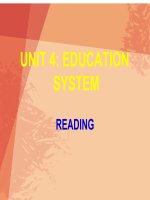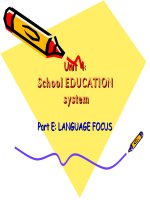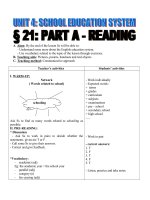UNIT 4: SCHOOL EDUCATION SYSTEM
Bạn đang xem bản rút gọn của tài liệu. Xem và tải ngay bản đầy đủ của tài liệu tại đây (1.21 MB, 24 trang )
THOAI NGOC HAU UPPER
SECONDARY SCHOOL
Kindergarten
Lower secondary school
College
Primary school
University
Upper secondary school
Can you name some kinds of schools in Vietnam?.
Nursery
= High school
= Middle school
•
Read the facts below and decide whether the statements
about schools in Viet Nam are true (T) or false (F). Then
compare your answers with your partners’.
Facts about schools in Viet Nam
1. Children start Grade 1 when they are 6 years old. ____
2. Schooling is compulsory from the age of 6 to 16. ____
3. The school year generally begins in early September
and ends in late May. ____
4. The students do not have any examinations when they
finish secondary school. ____
5. A school year consists of two terms. ____
T
F
T
F
T
Unit 4 : SCHOOL EDUCATION SYSTEM
A. READING :
* Vocabulary :
- compulsory / kәm’p
^
lsәrI / (a): ≠ optional /´ p ənəlɔ ʃ /
:
baét buoäc
Ex: Students at Thoai Ngoc Hau upper secondary school have to wear
uniform on Monday, Wednesday and Friday. So wearing uniform is
compulsory.
Unit 4 : SCHOOL EDUCATION SYSTEM
READING :
* Vocabulary :
an official document proving that
you have completed a course of study or passed an examination.
- certificate / sә’tIfIkәt / (n):
giấy chứng nhận
-
core subjects (n) :
- tuition fee / tjU’I∫әn fi: / (n) :
Ex: Lan couldn’t go on her college study because she couldn’t
afford the tuition fee of 3 million dongs a term.
Ex: Among the subjects at school I’m studying, maths, physics
, chemistry and biology are the most important. They are core
subjects.
- compulsory / kәm’p
^
lsәrI / (a): bắt buộc ≠ optional :
những môn học chính
học phí
- term / t3:m / (n) : học kỳ
Ex: In Viet Nam, a school year is divided into 2 terms: the first
term and the second term.
- curriculum / kә’rIkjUlәm / (n):
set of subjects that children
must study at school ( ch ng trình gi ng d y )ươ ả ạ
Suppy the missing letters in each of the following words:
* Checking vocabulary
1. c_ _ p _ l s _ _ _ o m u o r y
2. c _ r t _ _ i _ a _e e i f c t
3. _ e r _ t m
4. c _ _ r i _ _ l u _ u r c u m
5. _ u _ t _ _ n f _ e t i i o e
Reading Text:
Reading Text:
Schooling is compulsory for all English children
from the age of 5 to 16. The academic year in
England runs from September to July and is divided into 3
terms. Autumn Term is from the beginning of September
to mid-December. Spring Term is from the beginning of
January to mid-March and Summer Term from early April
to mid-July. Each term is separated by one-week break
called half term, usually at the end of October, mid-
February and the end of May.
Unit 4 : SCHOOL EDUCATION SYSTEM
There are two parallel school systems in England. The first
one is the state school system, which is free for all students and
paid for by the state. The second category is the “ independent”
or “ public” school system, which is fee-paying. The state school
system, which educates 93 % of the pupils in England, can be
divided into two levels of education: primary education and
secondary education.
The National Curriculum is set by the government and must
be followed in all state schools. It is made up of the following
subjects: English, Design & Technology, Geography, Maths,
Information Technology, Music, Science, Arts, Physical
Education, History, and a Modern Foreign Language. English,
Maths, and Science are core subjects, which are compulsory in
the national examinations at certain stages of the school
education system.
See the Table below for more information about the
school education system in England.
School education system in England
Level of
education
Grade / Year
(from – to )
Age
(from – to )
Pre-school
childcare
environment
3 - 4
In an Infant or
Primary school
4 – 5
Primary
education
1 – 3 5 – 7
4 – 6 8 – 10
Secondary
education
7 - 9 11 – 14
10 - 12
14 – 16 ( end
of compulsory
education
General Certificate
of Secondary
Education ( GCSE)
Task 1. Match the words or phrases in A with their
definitions in B.
A B
1. compulsory
2. term
3. curriculum
4. secondary education
5. primary education
6. state school
7. core
8. the General Certificate of
Secondary Education(GCSE).
___ a. A stage of study for children aged from 5
to 10
___ b. A stage of study for children aged from
11 to 16
___ c. Put into force by the law
___ d. Schools in which all children can attend
without paying tuition fees
___ e. The examinations children sit at the end
of compulsory education
___ f. A detailed plan for a course of study
offered in a school or college
5
4
1
6
8
3
1. When do children in England start their compulsory education
at school?
2. How many terms are there in a school year in England?
3. What are the two school systems in England?
4. Do children have to pay fees if they go to “independent” or
“public” schools?
5. How many core subjects are there in the national curriculum?
6. When can students take the GCSE examination?
Task 2: Answer the following questions
gift
3
0
2
5
1
5
L
o
s
e
t
u
r
n
g
i
f
t
2
0
1
0
L
o
s
e
m
a
r
k
Points
00
00
1 Schooling is compulsory for all English children from the age of 5
2 to16. The academic year in England runs from September to July and
3 is divided into 3 terms. Autumn Term is from the beginning of
4 September to mid-December. Spring Term is from the beginning of
5 January to mid-March and Summer Term from early April to mid-July.
6 Each term is separated by one-week break called half term, usually
7 at the end of October, mid-February and the end of May.
8 There are two parallel school systems in England. The first one is the
state
1.When do children in England start their
compulsory education at school?
1.From the age of 5. (line 1)
8 There are two parallel school systems in England. The first one is the
state
9 school system, which is free for all students and paid for by the state.
10 The second category is the “ independent” or “ public” school system,
11 which is fee-paying. The state school system, which educates 93 % of
12 the pupils in England, can be divided into two levels of education:
13 primary education and secondary education.
3. What are the two school systems in England?
- The state school and the “independent” or
“public” school systems.
1 Schooling is compulsory for all English children from the age of 5
2 to16. The academic year in England runs from September to July and
3 is divided into 3 terms. Autumn Term is from the beginning of
4 September to mid-December. Spring Term is from the beginning of
5 January to mid-March and Summer Term from early April to mid-July.
6 Each term is separated by one-week break called half term, usually
7 at the end of October, mid-February and the end of May.
8 There are two parallel school systems in England. The first one is the
state
2. How many terms are there in England?
3 terms: Autumn, Spring and Summer term
4. Do children have to pay fees if they go
to “independent” or “public” schools?
- Yes.
8 There are two parallel school systems in England. The first one is the state
9 school system, which is free for all students and paid for by the state.
10 The second category is the “ independent” or “ public” school system,
11 which is fee-paying. The state school system, which educates 93 % of
12 the pupils in England, can be divided into two levels of education:
13 primary education and secondary education.
16 The National Curriculum is set by the government and must be
17 followed in all state schools. It is made up of the following subjects:
18 English, Design & Technology, Geography, Maths, Information
19 Technology, Music, Science, Arts, Physical Education, History, and a
20 Modern Foreign Language. English, Maths, and Science are core
21 subjects, which are compulsory in the national examinations at certain
22 stages of the school education system.
5. How many core subjects are there in the
national curriculum?
- 3 core subjects (English, Maths and Science).
General Certificate
of Secondary
Education (GCSE)
11 – 14
14 – 16 (end of
compulsory
education)
7 - 9
10 - 11
Secondary
education
5 – 7
8 - 10
1 – 3
4 - 6
Primary
education
3 – 4
4- 5
childcare
environment
in an Infant or
Primary school
Pre-school
Age
(from – to)
Grade/ Year
(from – to)
Level of
education
6. When can students take the GCSE examination?
- When they finish the secondary school.
In England
In Vietnam
1. Levels in the
education system
3 levels
2. Age to start
primary school
5 years old
3. School system
State and public
school
4. Core subject
English, Maths
Science
5. National Exam
For GCSE
Yes
3 levels
6 years old
State and public
school
Maths, English
Literature
Yes
POINTS TO COMPARE
Note:
GCSE: General Certificate of Secondary Education
- Learn new words by heart.
- Read the text and do the tasks again.
- Answer the questions again.
- Prepare for the next lesson : Unit 4:
Speaking
HOMEWORK
1. The word compulsory in line 1 paragraph 1 is closet in meaning
to _____ .
A. necessary B. put in force by law C. optional D. difficult
2. The one - week break between two terms of a school year in
England is called ________
A. Autumn Term B. Spring Term
C. Summer Term D. half term
3. Which stage of study is for children aged from 11 to 16 ?
A. pre-school B. primary education
C. secondary education D. higher
education
4. How many subjects are there in the National Curriculum in
England ?
A. 12 B. 5 C. 6 D. 3
Extra Exercise 1. Choose the best answer to each of the
following questions.
Unit 4 : SCHOOL EDUCATION SYSTEM
5. All of the following are mentioned as core subjects in the
national examinations in England EXCEPT __________ .
A. Maths B. History C. Science D. English
6. The word “ It ” in line 3 paragraph 3 refers to ____
A. the state school B. the school education system
C. the core subject D. the National Curriculum
7. Which of the followings is NOT true about the school
education system in England ?
A. The state school system is free for all students, but the
“public” school system is fee-paying.
B. The academic year in England runs from September to July
and is divided into 2 terms.
C. There are two parallel school systems : the state school
system and the “ public” school system
D. English, Maths and Science are compulsory in the national
examinations.
Extra Exercise 2. Study the table below about the school
education system in Viet Nam and supply the missing
information.
Unit 4 : SCHOOL EDUCATION SYSTEM
Level of
education
Grade / Year
(from – to )
Age
(from – to )
Pre-school
Nursery school
3 - 4
optional education
(2) __________
4 – 5
(1) _______
education
1 – 5
(4) _________
(6) ___________
education
Secondary
education
Lower secondary
(3) ___________
11 – 14
Upper secondary
10 – 12
(5) _________
National High School
Graduation Exam
Primary
Kindergarten
6 – 9
6 – 10
15 – 17
compulsory









